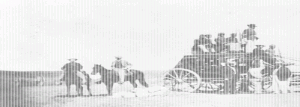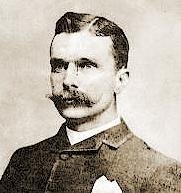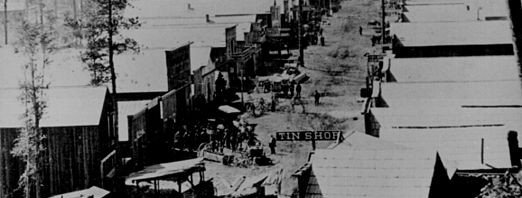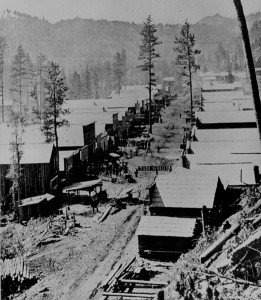Many people familiar with the old west would say that the most famous stagecoach to have plied the trails of the frontier west was the Deadwood Stagecoach. This is Deadwood as in Deadwood South Dakota and the Black Hills. Deadwood South Dakota could easily have been called the capitol of the Black Hills.The photo below is of Deadwood circa 1877.
This is where people from all walks of life hastened to as soon as gold was discovered in the nearby hills. The fact is that Deadwood was, in a way, founded by none other than George Armstrong Custer. It was Custer who led an expedition into the Black Hills which was at the time a very sacred area of the country to the Sioux Indians. The Sioux in fact had ownership of the Black Hills per a treaty with the federal government. When Custer filed a report of his expedition to the Black Hills, whose purpose was to ascertain if gold was truly there, he emphasized that gold was there in abundance. Somehow, at about the same time Custer filed his report, the startling information also found it’s way to the eastern newspapers.

 Anytime there was a flourishing stagecoach route, and the route to the Black Hills was one of them, there were stagecoach robbers. In that era they were often referred to as “highwaymen”. People handy with firearms such as Wyatt Earp were hired to sit beside the driver with a shotgun to protect passengers and gold from the highwaymen. There was a lot of criminal activity in the area. The infamous Sam Bass, pictured above, and his gang reportedly robbed the stage four times in two months. In fact, the Sam bass gang was credited with the largest Union Pacific train robbery that took place in Nebraska. The amount and value of gold dust being shipped via stagecoach was such that precautions were taken that included a special coach to protect the gold. The treasure box was bolted securely to the floor, the coach was even lined in lead, and there were two portholes guards could use to fire back at the robbers.
Anytime there was a flourishing stagecoach route, and the route to the Black Hills was one of them, there were stagecoach robbers. In that era they were often referred to as “highwaymen”. People handy with firearms such as Wyatt Earp were hired to sit beside the driver with a shotgun to protect passengers and gold from the highwaymen. There was a lot of criminal activity in the area. The infamous Sam Bass, pictured above, and his gang reportedly robbed the stage four times in two months. In fact, the Sam bass gang was credited with the largest Union Pacific train robbery that took place in Nebraska. The amount and value of gold dust being shipped via stagecoach was such that precautions were taken that included a special coach to protect the gold. The treasure box was bolted securely to the floor, the coach was even lined in lead, and there were two portholes guards could use to fire back at the robbers.
The transportation boom ended suddenly when the railroad reached Pierre, South Dakota. In 1880 the company moved the majority of its coaches and livestock to Pierre and opened an alternate line. After that the service on the Bismarck line was cut to tri-weekly trips and was soon after abandoned.
To illustrate how popular Buffalo Bill’s Deadwood Stagecoach was in his Wild West performances, while performing in England the highlight of one of the shows came when several monarchs, including the Prince of Wales and the kings of Denmark, Greece, Belgium, and Saxony, climbed aboard the Deadwood Stage with Buffalo Bill in the driver’s seat and rode around the arena while the Indians engaged in a mock attack. It doesn’t get much more real than that for the visiting monarchs. Obviously this was a show business first and gained wide publicity for the Wild West.
Today, you can see the original Deadwood Stagecoach which played a big part in Buffalo Bill’s Wild West performances. The stagecoach is on display at the Buffalo Bill Historical Center in Cody Wyoming. The Cody Historical Center began as a log cabin tribute to William F. Cody, founder and namesake of Cody Wyoming, and has materialized into a seven-acre building which houses five museums and a research center. The museum is located at 720 Sheridan Ave. and features everything about Buffalo Bill Cody, his Wild West and the old west in general. They have done an excellent job with this museum and I would recommend anyone traveling on a Wyoming vacation to make a visit there. It is the largest repository of William Cody artifacts in the west.


